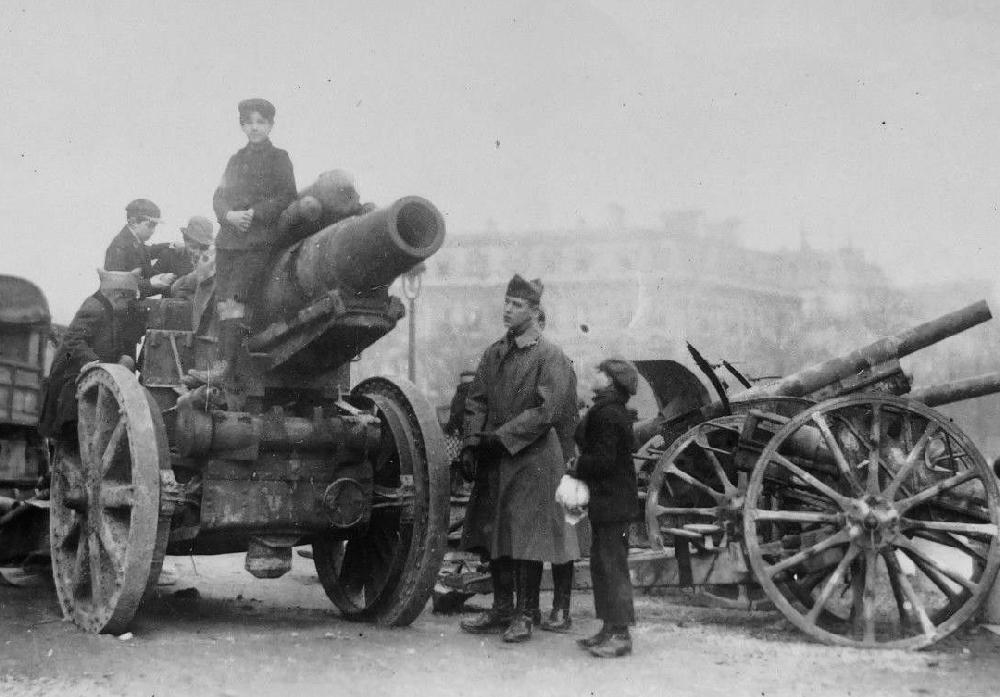
World War I Artillery: Germany

Figure 1.--This French postcard back photograph shows French children and an America Doughboy inspecting artillery pieces in a French city, probably Paris. It seems to be a public display of artillery. The photograph is not dated, but was probably taken in the winter just after the War (December 1918 through January-February 1919). To the right are several French 75s--the weapon that can be said to have saved France. (For comparison with te German gun--7.50cm. The boys are, however, nuch more interested in the massive German gun--the powerful, but ponderous 21-cm Morser 16 Howitzer. The rapid firing French 75 was very effective in the first mobil stage of the War helping to slow ad eventually the German drive on Paris. After the trenches appeared, you needed big guns to get at the entrenched soldiers.
|
|
Mortars were revived by the Germans because of their high angle firing. Only mortars were theoretically capable of delivering shells directly into enemy trench, although the firing accuracy was not very effective. The Germans also developed artillery shells for poson gas (1915). The term "Big Bertha" came to be used for any German heavy artillery piece. Actually there was only one real Big Bertha (Dicke Berta). It was at the time the largest artillery piece ever built. It was produced by the famed Krupp factory. The weapon was a 42cm howitzer (model L/14). The Germany Army contracted the development of the weapon in the aftermath of the Russo-Japanese War (1904-05).
The gun's name was derived from the name of Gustav Krupp's wife--Bertha Krupp von Bohlen und Halbach. Gustav Krupp managed the family owned firm. It was an enormously complex artillery puiece, both to deploy and operate. Despite the notiriety of the weapon, Krupp only built four. The first two were completed only days after the War broke out (August 9). The 420 mm guns fired a huge shell (820 kg). They had a range of 15km their 420mm shells The guns were too large to be moved. Thus they had to be transported in pices and assembled in the field. Thus a crew of about 1,000 men were required to operate the gun. The Big Bertha were first used to smsh the Belgan fortresses at Liege and Namur (August 1914). They were also used at Antwerp). They were subsequently used to smash other Allied strong pounts on the western Front. All four guns wre deployed at the protracted German seige of Verdun (beginning February 1916). German Chief of Staff Erich von Falkenhayn had cinceived of the Verdun offensive as a way of breaking the back of the French Army. The Germans failed to take Verdun and Falkenhayn was replaced. Actually he had in large measure suceeded. The French Army did not crack, but its morale was so weakened that for the rest of the War, offensive operaions had to be carried by the British and Americans. What Falkenhayn had not anticipated was the cost to Germany in smashing the French at Verdun. The Germany Army itself was disaterously weakened. The Germans after the Verdun offensive was terminated, decommisioned the Big Bertha guns. The Allies had developed artillery with even a longer range.
HBC

Navigate the Boys' Historical Clothing Web Site:
[Return to Main World War I artillery page]
[Return to Main World War I fighting page]
[About Us]
[Aftermath]
[Alliances]
[Animals]
[Armistace]
[Biographies]
[Causes]
[Campaigns]
[Casualties]
[Children]
[Countries]
[Declaration of war]
[Deciding factors]
-------[Diplomacy]
[Economics]
-------[Geo-political crisis]
[Home front]
[Intelligence]
[Military forces]
[Neutrality]
[Pacifism]
[People]
[Peace treaties]
[Propaganda]
[POWs]
[Russian Revolution]
[Terrorism]
[Trench warfare]
------[Technology]
[Weaponry]
[Bibliographies]
[Contributions]
[FAQs]
[Images]
[Links]
[Registration]
[Tools]
[Return to Main World War I page]
[Return to Main war essay page]
[Return to CIH Home page]
Created: 1:00 AM 1/5/2018
Last updated: 1:00 AM 1/5/2018



